Everyone has heard a story about that one company which did that one thing that drove phenomenal growth. DropBox, Uber, GoPro, LinkedIn…if each of them used a growth hack, surely there’s a single, simple growth hack for everyone, right?
WRONG.
Those stories are the exceptions, not the rule. What worked yesterday won’t work today much less tomorrow. For most businesses, growth comes through doing the hard things over and over again, and that is especially true with digital marketing. The digital marketing ecosystem has matured and become efficient to a point where most scalable tactics are priced near their actual value.
So…what DOES work?
Today’s “winners” usually have one (or more) of three things working for them:
- A structural advantage such as a unique product or relationship. For example, there is only one place online to buy a Casper mattress.
- An ability to monetize traffic at a much higher rate vs. competitors
- A capability to do the “hard things” of digital marketing
Check out (un)Common Logic’s data-driven approach to digital marketing here.
Read on to learn about four digital marketing tips – the “hard things” – that are proving successful for businesses in 2020.
Digital Marketing Tip #1: Market to the full funnel
The first digital marketing tip we’re going to cover is marketing to the full funnel. To illustrate the importance of marketing to the full funnel, we’ll discuss three of the digital ecosystem’s current trends:
Trend #1: 9 out of 10 buyers are not sure of the specific brand they want when they begin looking for information online [1]
Brands are certainly not dead, but customers are more open to considering more brands than ever before. This is great news if you are a “up-and-coming” brand in that you can insert yourself into the buying conversation of a customer.
This also means that you need to constantly introduce your brand to new customers to grow. A couple of years ago, (un)Common Logic had a prospective client whose CFO had recently taken over the marketing function. One of the first mandates he gave the team was, “Going forward, we are going to focus only on the marketing efforts which have the highest immediate ROI.”
This led to several changes in the organization around their high funnel marketing efforts. First, the organization shut down their earned social efforts. Then they turned off all high funnel display advertising. Finally, they reduced their paid search efforts to only those keywords that were resulting in an immediate sale.
For the first week or so after the change, the CFO looked like a hero. Costs dropped significantly while the number of leads for the sales team were flat. However, six weeks after the change, performance began to slide:
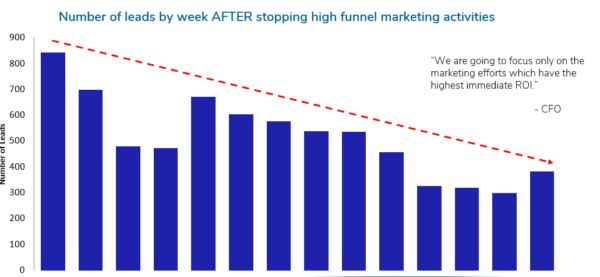
The CFO was sowing the fruit of the seeds he had planted: by not introducing his brand to prospective customers during their awareness and research process, his brand was not in the consideration set when it came time to purchase.
Must be present to win.
Trend #2: Prospective customers are doing more research online before engaging with a sales team or purchasing
Let’s look at the car industry. In 2005, the average buyer went to 5 different dealerships before purchasing a car. Last year, that number had dropped to 1.7.[2]

Additionally, in 2019, 53% of new car buyers bought a car after a single test drive or didn’t test any vehicle before making a purchase.
How have they already narrowed down all those choices? More and more buyers are doing their own independent research online on everything from cars, vacuums, and books to headphones, college, and shoes before either buying or engaging with a sales team. So it is essential to show up high in the funnel where the customer is getting their information during the research phase.
Trend #3: Low funnel digital marketing has become extremely difficult
Any digital marketer will tell you that the costs to acquire leads or customers from reliable, low funnel channels have been increasing. According to (un)Common Logic data and research, average Cost per Clicks (CPC), Cost per Lead (CPL) and Cost per Acquisition (CPA) have all increased YoY since 2010. As the market has gotten more competitive (and profitable for Google), it has become very difficult for marketers to profitably scale low funnel tactics.
What do these three trends mean for digital marketers wanting to grow their business? We know that customers are more open to new brands than ever before and are doing more and more independent research before buying. This combined with the increasing costs of low funnel media has led the high performing or “winning” digital marketers to develop a capability of being able to market and nurture high funnel traffic into paying customers.
I know what you’re thinking. HOW?
The first step is to figure out what high funnel channels work for your business. Where do large groups of your prospective and actual customers hang out online? Where do they go to research your product or service? Once you have figured out the best channels, then you can invest and create high quality interactions and nurture paths specific to your business.
Digital Marketing Tip #2: Select the best attribution model based on your business goals
The second digital marketing tip has to do with attribution models, or how you value your prospective customers’ digital interactions with your business. As we saw in the first digital marketing tip, we live in a “research first world.” As such, you can expect a prospective customer to visit your website several times before purchase. Their interactions with your website might look something like this:
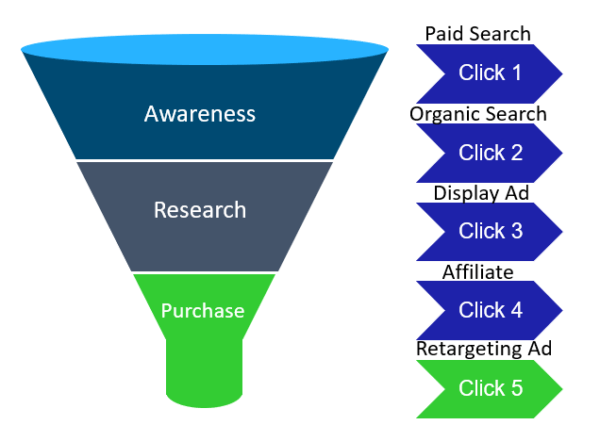
In this case it took five different interactions with the prospect before they became a customer. If you are going to try to scale high funnel digital marketing traffic, one of the keys is to identify and grow the sources of researcher traffic that will eventually convert into buyers.
For example, take two different high funnel search queries in the solar panel industry: “history of solar panels” and “benefits of solar panels.” While both terms are high in the funnel, based on (un)Common Logic’s experience, any search query which begins with “history of” has very little chance of ever becoming a customer. They’re curious but they’re not customers. On the other hand, searchers that use a “benefits of” query are more than curious – they’re more likely to buy at some point – either from you or your competitor.
In order to be able to spot and then act on the high funnel “winners” and “losers,” the attribution model that your company uses becomes important.
Most companies default to a “last click” attribution model. Using the customer journey above, all the credit from the sale or form completion is given to the last click. It looks like this:
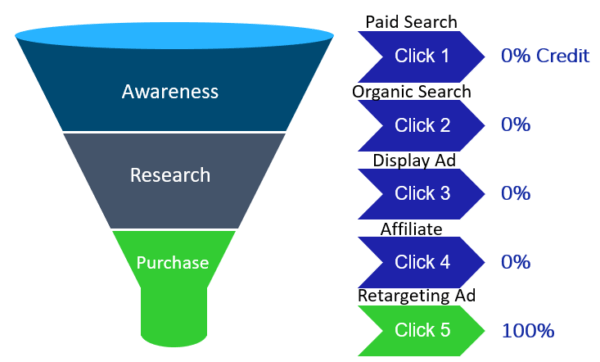
The issue with a “last click” attribution model is that it fundamentally rewards low-funnel acquisition activities and gives zero credit to any high funnel efforts. The result: most if not all high funnel tactics will be “unprofitable” from a marketing standpoint and thus eliminated over time.
“Last click” attribution is the default setting inside of Google analytics and most tracking solutions (as it is the easiest to understand). So, if you have not made a conscious effort to change it, you are probably using “last click” attribution modeling for your business.
There are several other attribution models including first click, time decay, and others. All of them have pros and cons. Most clients of (un)Common Logic use one called “position-based” to recognize the value created throughout the buying process. A position-based model looks something like this:
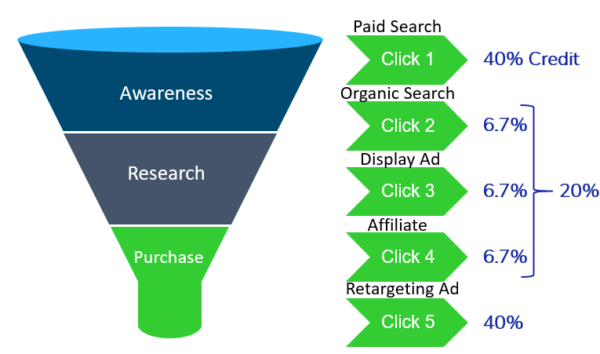
In our example, 40% of the value of the sale is attributed to the first and last click in a customer journey (for a total of 80%) while the remaining 20% is divided up between the clicks in between.
Let’s look at an example on how changing an attribution model can make a big difference in digital marketing. A little while ago, (un)Common Logic started working with a sustainability-based clothing company. The firm had some initial success at their product launch due to their company mission and the buzz it generated.
However, they quickly hit “the digital marketing wall.” They were using the default, “last-click” attribution model in their data and analytics platform and it was limiting their growth. They could only “afford” lower funnel tactics which had an immediate ROI associated with them. The result was the internal marketing team was unable to scale the business to meet overall growth objectives.
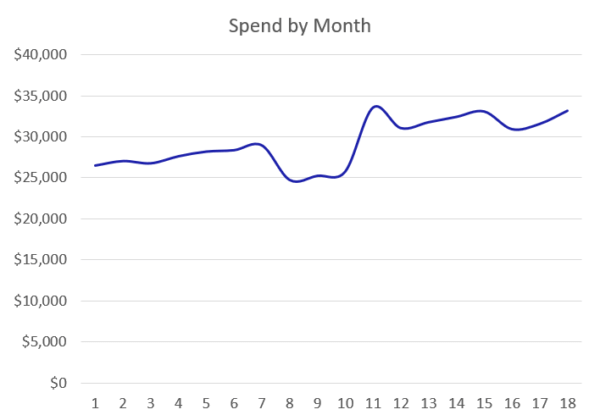
After 18 months, spend was up 40% – far less than the company growth plan of 200%. Ouch.
One of the first things the (un)Common Logic team did was change the attribution model to a “position-based” one. This provided insights into which channels were introducing the brand to new customers who were likely to buy sometime in the future. This allowed the team to test and grow high funnel channels and, ultimately, higher sales.
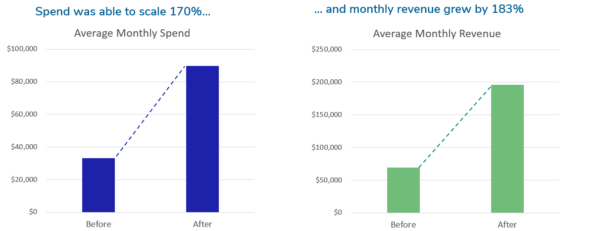
The best part for the company was that profitability based on return on ad spend also grew during this time.
Takeaways?
First, revisit your attribution model. If you are using Google Analytics you are, mostly likely, using a “last click” attribution model. Consider changing to a “position-based” model to spread the credit for the sale across the different customer interaction points. Second, take action on the data.
Digital Marketing Tip #3: Measure and act on the right metrics
Speaking of data, the third digital marketing tip is to use data to guide your decision-making.
But exactly what you measure is an indicator of what you value and how your team approaches digital marketing.
Recently I had the opportunity to present at a conference with Google. During their part of the presentation, Google showed the slide below which says that digital marketers should be measuring success on a customer Lifetime Value (LTV) basis. Their point is that you should evaluate the success of your marketing campaigns by comparing the cost of the campaigns against the lifetime value of the clients that you gain.
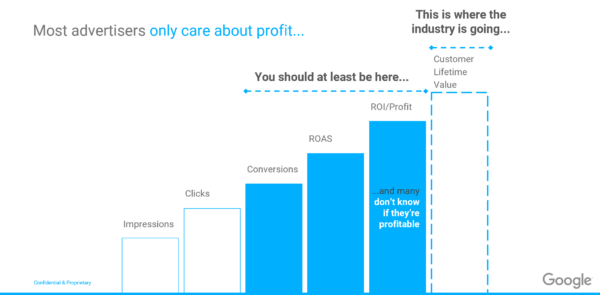
While this sounds good, (un)Common Logic has found in practice that calculating and acting on LTV can be a very difficult and subjective thing.
- How do you define a “customer lifetime”?
- One month?
- Two years?
- An actual lifetime?
- What follow-up purchase amount assumptions do you make?
For some of our clients, we have found that the assumptions used are so vague that one can make the data say whatever they want. To be clear, we are not against measuring success based on LTV. In fact we believe it is the best metric a digital marketer can use to measure success. However, business model challenges and measurement difficulties can make measurement of LTV impractical.
What do we do?
Instead, we think about measurement as a pyramid. The idea is to measure as high on the pyramid as is practical based on an organization’s business model and systems:
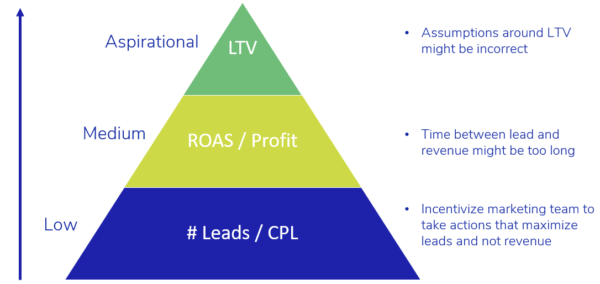
- Number of Leads/CPL – The advantage of measuring success on these metrics is that the data is usually very easy to get, clean, and timely. The downside is that this provides an incentive structure in which your marketing team may take actions that maximize leads and not revenue or profitability of your organization.
- ROAS / Profit – This is a better/more precise measurement than simply the number of leads and CPL. It considers immediate profitability of a new customer. The downside is that the timeframe between the initial lead and sale might be too long and follow-on purchases are not taken into account.
- LTV – This is the most accurate way to conceptually think about the value created from a specific marketing spend. However, as noted earlier, the assumptions around LTV might be incorrect.
A little while ago, (un)Common Logic started to work with a university to market their online degree programs. The internal marketing team had been previously measured against the number of leads and the CPL which their efforts produced. The team did not look at enrollment rates of their leads as “that’s a sales team problem.”
The university went through a process of switching their back-end tracking platforms which gave them the ability to measure marketing success on a “cost-per-enrollment” basis (similar to the ROAS level on the pyramid above). The systems fed the data back into the marketing channels that (un)Common Logic was managing.
Bringing in the cost-per-enrollment data resulted in some interesting insights on their historical marketing activities:
- Lead quality varied drastically by channel. For example, customers who came through Facebook enrolled in a program at about 1/5 the rate of other channels.
- Even within a channel, lead-to-enrollment costs varied dramatically by ad unit, placement, and keyword.
- Geography was important – even for online programs. Despite the programs being online and not having any geographical constraints, most of the students still came from within 100 miles from the physical campus.
With these learnings, the (un)Common Logic team was able to shift spend, set-up new campaigns, and change some of the settings and tactics. The results? If they are viewed under the old paradigm of number of leads and CPL, the metrics seem disappointing:
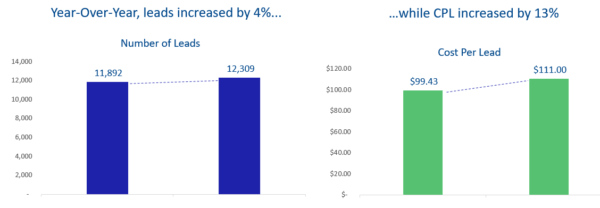
However, measuring enrollments and cost-per-enrollment told a different story:

The other benefit (un)Common Logic has seen from using higher level measurement rubrics is that it encourages the team to think about maximizing overall revenue.
Recently, I had the opportunity to speak with a large financial services company. In the past year they had shifted the focus of their marketing team from maximizing immediate ROAS to more of a lifetime value (LTV) measurement (their business model and internal systems supported this).
As expected, their marketing performance improved as they acquired fewer low LTV customers. What they didn’t expect, however, were the secondary effects of making the change. Once the internal conversation shifted from immediate ROAS to LTV, the marketing team figured out new and innovative ways to better monetize customers and leads. They started selling other products to their existing customers and creating partnerships for the prospects they were unable to service. The result was that the average LTV of the customer rose from $350 per customer to over $500. This allowed the company to market more aggressively and grow substantially.
The third digital marketing tip means asking: How are we measuring the success of our marketing efforts? Do our business model and systems allow us to push higher on the measurement pyramid?
Digital Marketing Tip #4: Test-Test-Test
And the fourth digital marketing tip is about testing. One of the core marketing philosophies of (un)Common Logic is “ABT” – Always Be Testing. Ideally, we encourage companies to carve out a portion of their monthly marketing budget to test and try new things (5-10%). The new things could be new channels, new keywords, new ad units, new technology, new value propositions, etc. The companies that are winning in the digital space have a formal testing plan with metrics and accountability.

This sounds so simple that it can be almost dismissed as a “filler point.” However, in our experience, it is amazing how few companies have a formal plan with owners over the various tests. Usually, when asked, we are told “everyone owns testing.” This typically means that no one owns testing.
Some people are intimidated by the idea of a testing plan and think it needs to be a complex document or software tracking system. Really, a simple Excel document which includes columns such as test, priority, hypothesis, and results will do. The “magic” is having it become a living document that team members are held accountable to and it is discussed, updated, and approved on a monthly/quarterly basis.
A testing plan can be as simple as this:
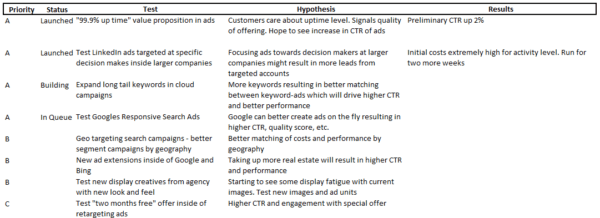
How to begin?
- Don’t be satisfied with the status quo. Ask your team how they would:
- Increase sales by 20% over the next year?
- Reduce cost-per-acquisition by 20% over the next year?
Just the exercise of asking one of these questions will see if your team has a test and grow mentality. If you get a list of excuses why growth is impossible, that is a warning signal.
- Ask your team for a quarterly testing plan and hold them accountable for the results.
If you find your team struggling with either one of the items above, you can have an outsider come in and look at your digital marketing efforts. Many firms such as (un)Common Logic will perform an external audit for a fee.
Conclusion
While stories of using “one weird trick” to scale digital marketing still linger, they’re a throwback. The companies that will succeed going forward are the ones who can follow the four digital marketing tips outlined above: market to the full funnel, choose the best-fit attribution model, measure success as high up the pyramid as possible, and create a testing plan with accountability.
Digital marketing success is not about doing one thing right – rather it is about doing many small things well.
Agree? Disagree? Have a question, comment, concern, or other feedback? Let us know – we love this stuff.
Contact us if you want to talk about how these trends may apply to your marketing efforts or about digital marketing in general here.
[1] Source: Google / Ipsos Connect, Jan. 2018
[2] McKinsey Innovating Automotive Retail | Google/NetPop Global Auto Shopper Study 2013 US Cut | Google/Kantar Automotive Path to Purchase 2019
Everyone has heard a story about that one company which did that one thing that drove phenomenal growth. DropBox, Uber, GoPro, LinkedIn…if each of them used a growth hack, surely there’s a single, simple growth hack for everyone, right?
WRONG.
Those stories are the exceptions, not the rule. What worked yesterday won’t work today much less tomorrow. For most businesses, growth comes through doing the hard things over and over again, and that is especially true with digital marketing. The digital marketing ecosystem has matured and become efficient to a point where most scalable tactics are priced near their actual value.
So…what DOES work?
Today’s “winners” usually have one (or more) of three things working for them:
- A structural advantage such as a unique product or relationship. For example, there is only one place online to buy a Casper mattress.
- An ability to monetize traffic at a much higher rate vs. competitors
- A capability to do the “hard things” of digital marketing
Check out (un)Common Logic’s data-driven approach to digital marketing here.
Read on to learn about four digital marketing tips – the “hard things” - that are proving successful for businesses in 2020.
Digital Marketing Tip #1: Market to the full funnel
The first digital marketing tip we’re going to cover is marketing to the full funnel. To illustrate the importance of marketing to the full funnel, we’ll discuss three of the digital ecosystem’s current trends:
Trend #1: 9 out of 10 buyers are not sure of the specific brand they want when they begin looking for information online [1]
Brands are certainly not dead, but customers are more open to considering more brands than ever before. This is great news if you are a “up-and-coming” brand in that you can insert yourself into the buying conversation of a customer.
This also means that you need to constantly introduce your brand to new customers to grow. A couple of years ago, (un)Common Logic had a prospective client whose CFO had recently taken over the marketing function. One of the first mandates he gave the team was, “Going forward, we are going to focus only on the marketing efforts which have the highest immediate ROI.”
This led to several changes in the organization around their high funnel marketing efforts. First, the organization shut down their earned social efforts. Then they turned off all high funnel display advertising. Finally, they reduced their paid search efforts to only those keywords that were resulting in an immediate sale.
For the first week or so after the change, the CFO looked like a hero. Costs dropped significantly while the number of leads for the sales team were flat. However, six weeks after the change, performance began to slide:

The CFO was sowing the fruit of the seeds he had planted: by not introducing his brand to prospective customers during their awareness and research process, his brand was not in the consideration set when it came time to purchase.
Must be present to win.
Trend #2: Prospective customers are doing more research online before engaging with a sales team or purchasing
Let’s look at the car industry. In 2005, the average buyer went to 5 different dealerships before purchasing a car. Last year, that number had dropped to 1.7.[2]

Additionally, in 2019, 53% of new car buyers bought a car after a single test drive or didn’t test any vehicle before making a purchase.
How have they already narrowed down all those choices? More and more buyers are doing their own independent research online on everything from cars, vacuums, and books to headphones, college, and shoes before either buying or engaging with a sales team. So it is essential to show up high in the funnel where the customer is getting their information during the research phase.
Trend #3: Low funnel digital marketing has become extremely difficult
Any digital marketer will tell you that the costs to acquire leads or customers from reliable, low funnel channels have been increasing. According to (un)Common Logic data and research, average Cost per Clicks (CPC), Cost per Lead (CPL) and Cost per Acquisition (CPA) have all increased YoY since 2010. As the market has gotten more competitive (and profitable for Google), it has become very difficult for marketers to profitably scale low funnel tactics.
What do these three trends mean for digital marketers wanting to grow their business? We know that customers are more open to new brands than ever before and are doing more and more independent research before buying. This combined with the increasing costs of low funnel media has led the high performing or “winning” digital marketers to develop a capability of being able to market and nurture high funnel traffic into paying customers.
I know what you’re thinking. HOW?
The first step is to figure out what high funnel channels work for your business. Where do large groups of your prospective and actual customers hang out online? Where do they go to research your product or service? Once you have figured out the best channels, then you can invest and create high quality interactions and nurture paths specific to your business.
Digital Marketing Tip #2: Select the best attribution model based on your business goals
The second digital marketing tip has to do with attribution models, or how you value your prospective customers’ digital interactions with your business. As we saw in the first digital marketing tip, we live in a “research first world.” As such, you can expect a prospective customer to visit your website several times before purchase. Their interactions with your website might look something like this:

In this case it took five different interactions with the prospect before they became a customer. If you are going to try to scale high funnel digital marketing traffic, one of the keys is to identify and grow the sources of researcher traffic that will eventually convert into buyers.
For example, take two different high funnel search queries in the solar panel industry: “history of solar panels” and “benefits of solar panels.” While both terms are high in the funnel, based on (un)Common Logic’s experience, any search query which begins with “history of” has very little chance of ever becoming a customer. They’re curious but they’re not customers. On the other hand, searchers that use a “benefits of” query are more than curious – they’re more likely to buy at some point – either from you or your competitor.
In order to be able to spot and then act on the high funnel “winners” and “losers,” the attribution model that your company uses becomes important.
Most companies default to a “last click” attribution model. Using the customer journey above, all the credit from the sale or form completion is given to the last click. It looks like this:

The issue with a “last click” attribution model is that it fundamentally rewards low-funnel acquisition activities and gives zero credit to any high funnel efforts. The result: most if not all high funnel tactics will be “unprofitable” from a marketing standpoint and thus eliminated over time.
“Last click” attribution is the default setting inside of Google analytics and most tracking solutions (as it is the easiest to understand). So, if you have not made a conscious effort to change it, you are probably using “last click” attribution modeling for your business.
There are several other attribution models including first click, time decay, and others. All of them have pros and cons. Most clients of (un)Common Logic use one called “position-based” to recognize the value created throughout the buying process. A position-based model looks something like this:

In our example, 40% of the value of the sale is attributed to the first and last click in a customer journey (for a total of 80%) while the remaining 20% is divided up between the clicks in between.
Let’s look at an example on how changing an attribution model can make a big difference in digital marketing. A little while ago, (un)Common Logic started working with a sustainability-based clothing company. The firm had some initial success at their product launch due to their company mission and the buzz it generated.
However, they quickly hit “the digital marketing wall.” They were using the default, “last-click” attribution model in their data and analytics platform and it was limiting their growth. They could only “afford” lower funnel tactics which had an immediate ROI associated with them. The result was the internal marketing team was unable to scale the business to meet overall growth objectives.

After 18 months, spend was up 40% - far less than the company growth plan of 200%. Ouch.
One of the first things the (un)Common Logic team did was change the attribution model to a “position-based” one. This provided insights into which channels were introducing the brand to new customers who were likely to buy sometime in the future. This allowed the team to test and grow high funnel channels and, ultimately, higher sales.

The best part for the company was that profitability based on return on ad spend also grew during this time.
Takeaways?
First, revisit your attribution model. If you are using Google Analytics you are, mostly likely, using a “last click” attribution model. Consider changing to a “position-based” model to spread the credit for the sale across the different customer interaction points. Second, take action on the data.
Digital Marketing Tip #3: Measure and act on the right metrics
Speaking of data, the third digital marketing tip is to use data to guide your decision-making.
But exactly what you measure is an indicator of what you value and how your team approaches digital marketing.
Recently I had the opportunity to present at a conference with Google. During their part of the presentation, Google showed the slide below which says that digital marketers should be measuring success on a customer Lifetime Value (LTV) basis. Their point is that you should evaluate the success of your marketing campaigns by comparing the cost of the campaigns against the lifetime value of the clients that you gain.

While this sounds good, (un)Common Logic has found in practice that calculating and acting on LTV can be a very difficult and subjective thing.
- How do you define a “customer lifetime”?
- One month?
- Two years?
- An actual lifetime?
- What follow-up purchase amount assumptions do you make?
For some of our clients, we have found that the assumptions used are so vague that one can make the data say whatever they want. To be clear, we are not against measuring success based on LTV. In fact we believe it is the best metric a digital marketer can use to measure success. However, business model challenges and measurement difficulties can make measurement of LTV impractical.
What do we do?
Instead, we think about measurement as a pyramid. The idea is to measure as high on the pyramid as is practical based on an organization’s business model and systems:

- Number of Leads/CPL - The advantage of measuring success on these metrics is that the data is usually very easy to get, clean, and timely. The downside is that this provides an incentive structure in which your marketing team may take actions that maximize leads and not revenue or profitability of your organization.
- ROAS / Profit – This is a better/more precise measurement than simply the number of leads and CPL. It considers immediate profitability of a new customer. The downside is that the timeframe between the initial lead and sale might be too long and follow-on purchases are not taken into account.
- LTV – This is the most accurate way to conceptually think about the value created from a specific marketing spend. However, as noted earlier, the assumptions around LTV might be incorrect.
A little while ago, (un)Common Logic started to work with a university to market their online degree programs. The internal marketing team had been previously measured against the number of leads and the CPL which their efforts produced. The team did not look at enrollment rates of their leads as “that’s a sales team problem.”
The university went through a process of switching their back-end tracking platforms which gave them the ability to measure marketing success on a “cost-per-enrollment” basis (similar to the ROAS level on the pyramid above). The systems fed the data back into the marketing channels that (un)Common Logic was managing.
Bringing in the cost-per-enrollment data resulted in some interesting insights on their historical marketing activities:
- Lead quality varied drastically by channel. For example, customers who came through Facebook enrolled in a program at about 1/5 the rate of other channels.
- Even within a channel, lead-to-enrollment costs varied dramatically by ad unit, placement, and keyword.
- Geography was important – even for online programs. Despite the programs being online and not having any geographical constraints, most of the students still came from within 100 miles from the physical campus.
With these learnings, the (un)Common Logic team was able to shift spend, set-up new campaigns, and change some of the settings and tactics. The results? If they are viewed under the old paradigm of number of leads and CPL, the metrics seem disappointing:

However, measuring enrollments and cost-per-enrollment told a different story:

The other benefit (un)Common Logic has seen from using higher level measurement rubrics is that it encourages the team to think about maximizing overall revenue.
Recently, I had the opportunity to speak with a large financial services company. In the past year they had shifted the focus of their marketing team from maximizing immediate ROAS to more of a lifetime value (LTV) measurement (their business model and internal systems supported this).
As expected, their marketing performance improved as they acquired fewer low LTV customers. What they didn’t expect, however, were the secondary effects of making the change. Once the internal conversation shifted from immediate ROAS to LTV, the marketing team figured out new and innovative ways to better monetize customers and leads. They started selling other products to their existing customers and creating partnerships for the prospects they were unable to service. The result was that the average LTV of the customer rose from $350 per customer to over $500. This allowed the company to market more aggressively and grow substantially.
The third digital marketing tip means asking: How are we measuring the success of our marketing efforts? Do our business model and systems allow us to push higher on the measurement pyramid?
Digital Marketing Tip #4: Test-Test-Test
And the fourth digital marketing tip is about testing. One of the core marketing philosophies of (un)Common Logic is “ABT” – Always Be Testing. Ideally, we encourage companies to carve out a portion of their monthly marketing budget to test and try new things (5-10%). The new things could be new channels, new keywords, new ad units, new technology, new value propositions, etc. The companies that are winning in the digital space have a formal testing plan with metrics and accountability.

This sounds so simple that it can be almost dismissed as a “filler point.” However, in our experience, it is amazing how few companies have a formal plan with owners over the various tests. Usually, when asked, we are told “everyone owns testing.” This typically means that no one owns testing.
Some people are intimidated by the idea of a testing plan and think it needs to be a complex document or software tracking system. Really, a simple Excel document which includes columns such as test, priority, hypothesis, and results will do. The “magic” is having it become a living document that team members are held accountable to and it is discussed, updated, and approved on a monthly/quarterly basis.
A testing plan can be as simple as this:

How to begin?
- Don’t be satisfied with the status quo. Ask your team how they would:
- Increase sales by 20% over the next year?
- Reduce cost-per-acquisition by 20% over the next year?
Just the exercise of asking one of these questions will see if your team has a test and grow mentality. If you get a list of excuses why growth is impossible, that is a warning signal.
- Ask your team for a quarterly testing plan and hold them accountable for the results.
If you find your team struggling with either one of the items above, you can have an outsider come in and look at your digital marketing efforts. Many firms such as (un)Common Logic will perform an external audit for a fee.
Conclusion
While stories of using “one weird trick” to scale digital marketing still linger, they’re a throwback. The companies that will succeed going forward are the ones who can follow the four digital marketing tips outlined above: market to the full funnel, choose the best-fit attribution model, measure success as high up the pyramid as possible, and create a testing plan with accountability.
Digital marketing success is not about doing one thing right - rather it is about doing many small things well.
Agree? Disagree? Have a question, comment, concern, or other feedback? Let us know – we love this stuff.
Contact us if you want to talk about how these trends may apply to your marketing efforts or about digital marketing in general here.
[1] Source: Google / Ipsos Connect, Jan. 2018
[2] McKinsey Innovating Automotive Retail | Google/NetPop Global Auto Shopper Study 2013 US Cut | Google/Kantar Automotive Path to Purchase 2019

